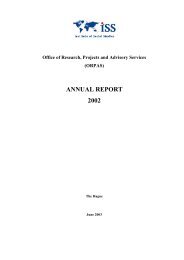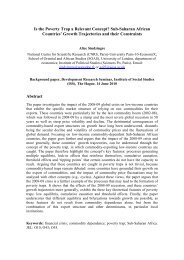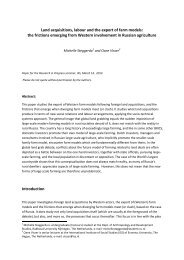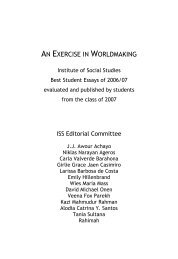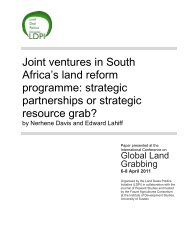AN EXERCISE IN WORLDMAKING 2009 - ISS
AN EXERCISE IN WORLDMAKING 2009 - ISS
AN EXERCISE IN WORLDMAKING 2009 - ISS
Create successful ePaper yourself
Turn your PDF publications into a flip-book with our unique Google optimized e-Paper software.
100 BERNICE CAMPOS ROLD<strong>AN</strong><br />
Table 1<br />
Characteristics of survival and growth-oriented enterprises<br />
Survival(ist)<br />
(Street businesses, Community of the<br />
poor, [Microenterprise,] Informal ownaccount<br />
proletariat, Sub-subsistence)<br />
Ease of entry, low capital requirements,<br />
skills and technology<br />
Involuntary entrepreneurs<br />
Female majority<br />
Maximizing security, smoothing consumption<br />
Part of diversification strategy, often<br />
run by idle labor, with interruptions,<br />
and/or part-time<br />
Embeddedness in social relations, obligation<br />
to share<br />
Growth(-oriented)<br />
(Small-scale family enterprise, Intermediate<br />
sector, [Microenterprise,]<br />
Petty bourgeoisie, Micro-accumulation)<br />
Barriers to entry<br />
Entrepreneurs by choice, often with<br />
background in regular employment<br />
Male majority<br />
Willingness to take risks<br />
Specialization<br />
Disembeddedness, ability to accumulate<br />
Source: Berner, Gomez and Knorringa (Table 1, 2008: 7)<br />
We can see how motivation is one factor that underpins the characteristics<br />
of survivalist entrepreneurs, who are described as ‘simply not<br />
interested in expanding their business. They are forced into creating a<br />
firm by unemployment or other economic shocks, while growth-oriented<br />
entrepreneurs make an affirmative choice based on the identification of a<br />
specific business opportunity’ (Reynolds et al., 2004, in Berner, Gomez<br />
and Knorringa, 2008: 8).<br />
Other factors are risk aversion and handling the business as a survival<br />
effort. To illustrate, the authors draw on research findings in India revealing<br />
that 20 percent of households with a microenterprise also maintained<br />
a second and even third income-generating activity (ibid: 9, citing<br />
Banerjee and Duflo, 2007; Banerjee et al., 2006). This risk-averse and<br />
survivalist attitude is expressed by the poor in other countries and regions<br />
in the South, where ‘the percentages rise to 47 percent in Cote<br />
d’Ivoire and Indonesia, 36 percent in Pakistan, 24 percent in Mexico and<br />
20.5 percent in Peru. A survey of eight districts in West Bengal found<br />
that the median family had three working members and seven occupations’.




